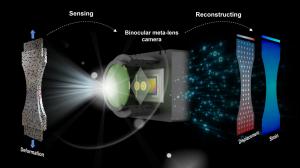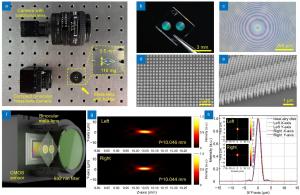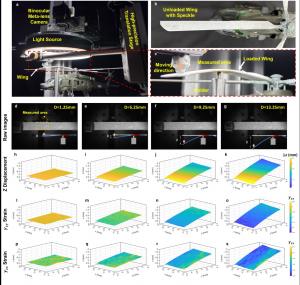Revolutionizing Digital Imaging Correlation: Meta-lens Open New Horizons
Meta-lens is one of the promising flat optical imaging devices that are ultra-thin, customizable, and well-suited for use in confined spaces.
CHENGDU, SICHUAN, CHINA, October 9, 2025 /EINPresswire.com/ -- Deformation occurs universally across nature and engineering, critical for safety and performance in structures and biomedical applications. Digital Image Correlation (DIC) is an optical technique that measures these deformations with high precision. It uses a speckle pattern or natural texture, tracking surface changes under load via image analysis. While early DIC was limited to 2D, modern systems capture 3D deformations in real time. Current research focuses on two paths: multi-camera setups for higher dimensions and robustness, and single-camera systems with added optics to reduce cost and complexity. However, both approaches face challenges in calibration, synchronization, portability, and precision driving the need for innovative, compact optical solutions suitable for non-laboratory environments.To address the challenges of traditional DIC systems, Prof. Mu Ku Chen from the City University of Hong Kong, along with Prof. Shengxian Shi and Prof. Fei Qi from Shanghai Jiao Tong University, proposed a novel Meta-lens DIC technology. This research integrates advanced optical meta-lenses with traditional DIC techniques. Compared to conventional stereo systems, the binocular meta-lens camera developed in this study is more compact and integrated. The research team implemented a pair of meta-lenses and integrated them into a CMOS sensor, creating a compact binocular meta-lens camera. This camera is significantly smaller than those equipped with a single commercial lens, and the binocular meta-lens itself weighs only 116 mg, much lighter than commercial lenses.
In the in-plane displacement test, the BM-DIC achieved high precision with a standard deviation (σ) below 2 µm. In a comparison with conventional stereo-DIC systems during the rubber block compression test, the BM-DIC system achieved relative strain field errors of around 1%, even though its baseline length was only 1/75 of the stereo-DIC system. To further validate its effectiveness, the team conducted a helicopter rotor bending test. Speckle patterns were applied to the rotor surface, and a binocular meta-lens camera was positioned above the rotor to capture speckle images before and during loading. The BM-DIC system successfully measured three-dimensional displacement and bending strain fields, even under significant out-of-plane motion, where traditional 2D-DIC would fail.
This study combines advanced micro-nano optical technology with traditional surface strain measurement techniques, breathing new life into classical solid mechanics testing tools. It expands the potential applications of DIC and optical metamaterial technologies for compact, portable, and space-constrained measurement scenarios, providing new insights for the miniaturization of DIC systems.
About the Research Group:
The research, titled "Meta-lens Digital Image Correlation", was published on Opto-Electronic Advances. The co-first authors are Dr. Zhou Zhao, Dr. Xiaoyuan Liu, and graduate student Mr. Yu Ji from Shanghai Jiao Tong University. The corresponding authors are Prof. Mu Ku Chen, Prof. Shengxian Shi, and Prof. Fei Qi. This work was supported by the Research Grants Council of the Hong Kong SAR, City University of Hong Kong, the National Natural Science Foundation of China, the China Postdoctoral Science Foundation, the Institute of Aero Engine at Shanghai Jiao Tong University, and Prof. Tanaka’s group at RIKEN.
Mu Ku Chen received his Ph.D. from the Department of Physics at the National Taiwan University in 2019. At present, he is an Assistant Professor at the Department of Electrical Engineering at the City University of Hong Kong. His research focuses on nanophotonics, micro & nano-fabrication, and meta-devices for novel applications. He published 60 SCI papers, including Science, Chemical Reviews, Nature Nanotechnology, Advanced Materials, Light: Science & Applications, etc. His research results were awarded China's Top 10 Optical Breakthroughs (2018 and 2020). He was awarded the Gold Medal at the 49th International Exhibition of Inventions of Geneva 2024.
Shengxian Shi received his Bachelor’s degree and Master’s degree from National University of Defense Technology and Central South University in 2002 and 2005, respectively. He pursued further research and obtained his PhD degree from The University of Liverpool, UK in 2010. After that he joined Shanghai Jiao Tong University and continued this research on developing optical diagnostic techniques. Aiming for high-temperature, flow field and 3D geometry measurement for aeroengine, he focused on light-field based measurement techniques, and developed light-field particle image velocimetry, light-field multispectral thermometry. Intrigued by the compactness and multifunctionality of meta-lens, most of his recent efforts have focused on Meta-lens Particle Image Velocimetry and Dispersive Meta-lens Thermometry. His researches have been funded my NSFC (5), National Major Science and Technology Project on Aero Engines and Gas Turbines (2) and SJTU-AECC HAPRI projects. He composed book (Springer Nature) and published many journal papers on Advanced Materials, Journal of Fluid Mechanics, Optics Letters, Experiments in Fluids.
Fei Qi, a chair professor at Shanghai Jiao Tong University. He has received the Talent Program of the Chinese Academy of Sciences (2002), the National Outstanding Youth Fund (2009), Fellow of the American Physical Society (2012), Fellow of the Combustion Institute (2018), the Second Prize of the National Natural Science Award (2018), Humboldt Research Award (2021), and Shanghai Science and Technology Elite Award (2022). He served as the Program Chair of the 38th International Symposium on Combustion, and Editor-in-Chief of journal Applications in Energy and Combustion Science and Proceedings of the Combustion Institute and editorial board member of several international journals. His research focuses on combustion diagnostics, combustion kinetics, and combustion instability. He has published over 350 SCI papers in journals. He is the principal investigator of the Major Research Instrument Project of NSFC "Research Facility for High-Temperature High-Pressure Turbulent Combustion Based on Ultra-High-Framerate Laser Diagnostics".
Read the full article here: www.oejournal.org/oea/article/doi/10.29026/oea.2025.250014
Andrew Smith
Charlesworth
+ +44 7753 374162
marketing@charlesworth-group.com
Visit us on social media:
LinkedIn
YouTube
Other
Legal Disclaimer:
EIN Presswire provides this news content "as is" without warranty of any kind. We do not accept any responsibility or liability for the accuracy, content, images, videos, licenses, completeness, legality, or reliability of the information contained in this article. If you have any complaints or copyright issues related to this article, kindly contact the author above.



